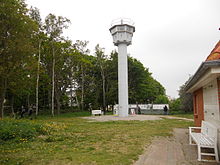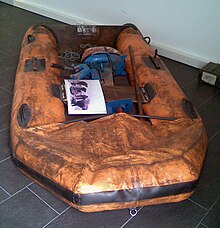Ostsee-Grenzturm Kühlungsborn
The Baltic Sea border tower in Kühlungsborn is a former watchtower of the coast border brigade of the border troops of the GDR . As a sea border observation tower (BT 11) it was one of a series of formerly 27 towers of this type on the GDR coast , two of which have been preserved.
History and architecture
The tower, built in 1972, is located in Kühlungsborn Ost in the immediate vicinity of the beach promenade , not far from the pier . The GDR border guards belonging to the Coastal Border Brigade were given the task of observing ship movements on the Baltic Sea from the tower and identifying attempts to escape . Using a fixed telescope with high magnification, the four-man crew were able to search an area of up to 12 nautical miles from the pulpit . At night, the near area could be illuminated by a searchlight mounted on the roof of the tower. The basic equipment of the pulpit included a radio system, an emergency power generator and a heater. There were lockable loopholes below the windows. The pulpit is accessible via staggered steel ladders. The guards recorded every seemingly suspicious movement. The radio equipment was integrated into the border reporting network, so border ships and land units could be alerted immediately.
The Baltic Sea limit tower shaped the landscape of the Baltic Sea coast. The soldiers of the border brigade patrolled the beach and were supported by mobile searchlights and fully equipped emergency vehicles if necessary.
Support association
An association prevented the planned demolition in 1990 and restored the building and the technical facilities on its own initiative. In 1991 the border tower was declared a historical monument and is included in the list of architectural monuments in Kühlungsborn . The tower is accessible via an internal ladder.
Documented escape attempts
Explanatory display boards in the outdoor area describe various successful escape attempts that were also prevented by the border troops. One of the most famous refugees was Peter Döbler , he swam through the Baltic Sea in 1969 and reached the island of Fehmarn, 40 km away, after about 25 hours . In the exhibition room next to the watchtower, some items used for escape, such as For example, a rubber dinghy fled by a family with two children is shown. Parts of the soldiers' equipment are also on display. The effects of the former Baltic Sea border on the residents are shown.
gallery
swell
- Grenzturm eV Baltic Sea Border Tower, memorial and meeting place in memory of the division of Germany Brochure, published with the support of the State Commissioner for Mecklenburg-Western Pomerania for the Stasi documents.
See also
Web links
- Literature on the Baltic Sea border tower in Kühlungsborn in the state bibliography MV
- Website of the Ostsee-Grenzturm eV
Individual evidence
- ^ Grenzturm eV Ostsee-Grenzturm, memorial and meeting place in memory of the German division Brochure, published with the support of the State Commissioner for Mecklenburg-Western Pomerania for the Stasi documents.
Coordinates: 54 ° 9 '14.85 " N , 11 ° 45' 32.59" O





